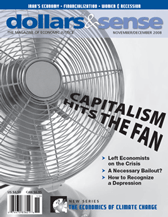The Impasse Ahead
This is a web-only article from the website of Dollars & Sense: The Magazine of Economic Justice available at http://www.dollarsandsense.org

This is a web-only article, available only at www.dollarsandsense.org.
Subscribe Now
at a 30% discount.
Until quite recently the main open question about the financial crisis was when investors would return to the stock market and recapitalize banks, and the answer was: when they felt confident that they are not throwing good money after bad. The dubious assets still buried deep in bank balance sheets had to be cleansed, but the trouble was that trying to sell them off would push down their market value further, compounding banks’ losses. In short, the bottom could not be reached until the investors returned, yet they would stay on the sidelines until asset prices hit bottom.
The initial Paulson rescue package aimed at addressing this dilemma by trying to provide a floor to falling asset prices. It was meant to work like the kiss of the beautiful princess, restoring the frog of bad assets to their “true” market value, and the hope was that financial markets would go on functioning normally thereafter. But the Paulson Plan failed to transform investors’ expectations. It failed to persuade financial markets that it could provide the bottom the market would not.
Now, we are on a new plane. It is as though the market has charged ahead to search and find its own bottom the hard way, focusing its expectations on the fallout in the real economy and its feedback on the financial system. Most notably, consumer spending has now taken a dive and unemployment is going up, bringing to an end, at long last, the U.S. consumers’ role as the consumer of last resort for the world. This has by now the feel of the long-talked-about great unraveling of the global imbalances, which suggests that a protracted and painful process is upon us. No surprise then that in quick succession the focus of crisis management shifted from restoring the liquidity of the credit system to preventing credit contraction by direct intervention in banks—if need be. The de facto nationalization of Citibank shows that the battleground has clearly shifted.
In this new landscape, it is unlikely that market sentiment will improve before the real economy shows a clear sign of rebound. Thus, government efforts to stimulate aggregate demand will be doubly important. Leaving aside the possibility of full nationalization of most major U.S. banks and direct intervention in the housing market, fiscal measures to stimulate demand, e.g. government spending and lower taxes, will be what much of crisis management in the period ahead will rely on; monetary policy measures such as interest rate cuts will no longer do. The remedy against the worsening downturn and steadily rising unemployment will be things like stepped-up public investment in infrastructure, health, and education, increased unemployment insurance, along with steeply increased federal aid to the states—all deficit financed.
But a marked increase in government spending in the United States will require the rest of the world to accumulate more U.S. liabilities at a much faster clip than before as it will tend to raise U.S. imports and thus the trade deficit. Today, with the dollar rising in value, that does not appear to be a problem, but how long that can last is hard to tell. For a long time now foreigners kept increasing their lending to the United States to be able to export more goods, and recycling their surpluses to the U.S. financial system to get a better deal on their savings. Currently, they are demanding dollars to weather the global financial storm. Leaving aside the issue of how long that can go on, the question is: how can the market find its bottom when the money keeps pouring in? For the U.S. consumer will have to cease overspending on borrowed money—which has led to the crisis in the first place.
Large public investment and government spending will be able to save the U.S. economy from going into deep recession only if the capital inflow into the United States continues at an increasing rate. But that also means that the United States will continue to consume beyond its means, since public spending will have been substituted for sagging private consumption. With no bottom thus in sight, a clear resolution to the financial crisis will then be unlikely to emerge. Markets may end up stuck in limbo, perpetually waiting for the other shoe to drop in the form of a run on the dollar. The main danger would then be the urge to hedge against the dollar at the first sign of improvement—here in the United States alone, even if the foreigners hold onto their dollars—reaching a crescendo in the event of any setback the United States suffers politically, economically or militarily in the near future.
If capital inflow from the rest of the world into the United States gradually weakens, the likely outcome would be stagflation, in which case government spending would have to be cut back and interest rates pulled up to check rising prices, which would renew the threat of a deepening downturn and soaring unemployment. We had a glimpse of how that might unfold in the run-up in prices of oil and commodities over the summer, when investors bought commodities to hedge against the dollar and the rising prices of oil became a barometer of the waning confidence in the U.S. currency.
All this means that the success of the massive fiscal stimulus that the incoming Obama administration is promising will very much depend ultimately on what happens with the dollar. It might take nothing less than a new international financial structure to prevent the U.S. and world economies from getting stuck in a prolonged depression.

